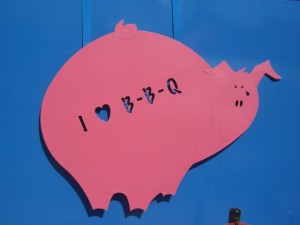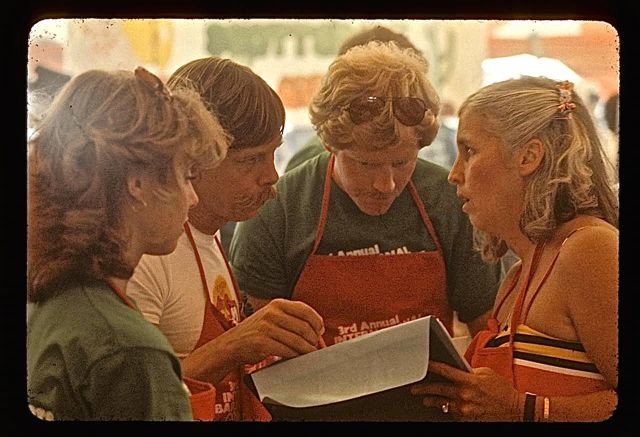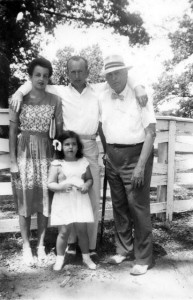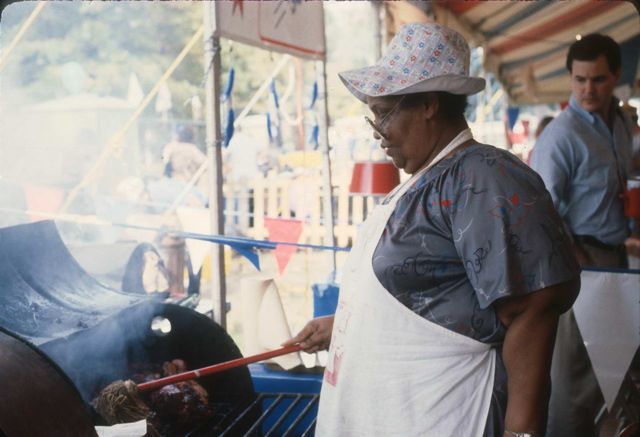 I’m a vegetarian who eats pork barbecue. Odd? Not really, I was born and bred in the Delta of the Deep South that hovers around the Mississippi River where Arkansas, Mississippi and Tennessee bite onto each other. One cannot be a true southerner without raising a cheer when the topic of pork barbecue is brought up. In fact, it is so imbedded in the old South, I don’t mean the Nuevo Southerner, but the ones with long lines of family, black and white, who originally settled in the old Indian territories, from which was created the modern Delta. Bluntly, our passion rests on Delta Blues and Delta Barbecue. There are tears in both. To be truthful, indulging in pork barbecue (this is not a Catholic indulgence in order to get a front row seat in heaven) is definitely a religious experience to those who know how indigenous pork barbecue and its sauce tastes – that vinegary-tomato blend not violated by apple juice, maple syrup, hot peppers and other ridiculous insertions with which contest competitors experiment thinking they are going to jerk some unskilled judge into voting for their entry. Truly, superb barbecue should slide to fame for the tenderness of its meat, the dry rub that flavors it, and the cooking ritual. But easier are the sauces to agitate the taste buds. The right sauce is hard to find today, since everybody has become an expert, and as I periodically test some of the old barbecue saints, I get unruly when someone alters their “good ole” sauce or packs it with so much hot stuff your mouth bubbles up in blisters – all to please the public or clients.
I’m a vegetarian who eats pork barbecue. Odd? Not really, I was born and bred in the Delta of the Deep South that hovers around the Mississippi River where Arkansas, Mississippi and Tennessee bite onto each other. One cannot be a true southerner without raising a cheer when the topic of pork barbecue is brought up. In fact, it is so imbedded in the old South, I don’t mean the Nuevo Southerner, but the ones with long lines of family, black and white, who originally settled in the old Indian territories, from which was created the modern Delta. Bluntly, our passion rests on Delta Blues and Delta Barbecue. There are tears in both. To be truthful, indulging in pork barbecue (this is not a Catholic indulgence in order to get a front row seat in heaven) is definitely a religious experience to those who know how indigenous pork barbecue and its sauce tastes – that vinegary-tomato blend not violated by apple juice, maple syrup, hot peppers and other ridiculous insertions with which contest competitors experiment thinking they are going to jerk some unskilled judge into voting for their entry. Truly, superb barbecue should slide to fame for the tenderness of its meat, the dry rub that flavors it, and the cooking ritual. But easier are the sauces to agitate the taste buds. The right sauce is hard to find today, since everybody has become an expert, and as I periodically test some of the old barbecue saints, I get unruly when someone alters their “good ole” sauce or packs it with so much hot stuff your mouth bubbles up in blisters – all to please the public or clients.
 Who am I to be able to even talk about these issues? Well, way back in 1976, after a magazine article (I think it was Esquire) claimed that North Carolina was the king of southern barbecue, I was assigned by City of Memphis Magazine to survey and discover all the barbecue pits in Shelby County because we wanted to challenge the Tarheels claim to be the best. In my first survey I found 64 barbecue pits – and then had to rank them. I remember the top ten included Randevouz, Brady and Lil’s, (now known as Bar-B-Q shop ), Cozy Corner (recently burned)…and they still are in business. It was in the early years of the Memphis in May International Barbecue contest that Germantown Commissary, Willingham’s, and Corkys and others got their boost into popularity and people began considering barbecue as a treasure and everyone, had an opinion about taste, dry or wet, how to baste, what kind of pork, styles of cooking, types of pits. In the original survey, we left no ‘cue un-sampled and discovered a couple who were right on, but so small, that when the city bbq lovers swarmed down upon the small kitchen, the chef ran out of material and didn’t know how to cook for masses. But there’s more in my resume than that experience.
Who am I to be able to even talk about these issues? Well, way back in 1976, after a magazine article (I think it was Esquire) claimed that North Carolina was the king of southern barbecue, I was assigned by City of Memphis Magazine to survey and discover all the barbecue pits in Shelby County because we wanted to challenge the Tarheels claim to be the best. In my first survey I found 64 barbecue pits – and then had to rank them. I remember the top ten included Randevouz, Brady and Lil’s, (now known as Bar-B-Q shop ), Cozy Corner (recently burned)…and they still are in business. It was in the early years of the Memphis in May International Barbecue contest that Germantown Commissary, Willingham’s, and Corkys and others got their boost into popularity and people began considering barbecue as a treasure and everyone, had an opinion about taste, dry or wet, how to baste, what kind of pork, styles of cooking, types of pits. In the original survey, we left no ‘cue un-sampled and discovered a couple who were right on, but so small, that when the city bbq lovers swarmed down upon the small kitchen, the chef ran out of material and didn’t know how to cook for masses. But there’s more in my resume than that experience.
I was born into barbecue 75 years ago, sort of. It was the first exotic food I was allowed to eat, though never at the dining room table. It was sensual, sexual, and wild, and there was nothing better than a barbecue among friends prepared with secret sauces and the cooks heavily inspired by plenty of Bourbon. But note, in those days, barbecue was an outside experience. Few would serve indoors holy barbecue with its messy sauce and spices, which you ate with fingers until they couldn’t be distinguished from the pork itself. Sauce stains ruined Mama’s napkins. It was a paper napkin event, because those could be tossed.
True Delta connoisseurs dismiss beef barbecue (usually too sweet), brisket, buffalo, goat, lamb, oysters, snake, tongue, whatever, and heaven help us, chicken (whose preparation doesn’t take long enough to get the spirit in its bones. ) Vegetarian barbecue, and I’m stretching it here, because there really isn’t this category, is just vegetable – try Portabella mushrooms – covered in barbecue sauce, as if sauce made the man, so to speak. It might work with Brussel sprouts. Where you’d turn a heated church service into a pork celebration was half of the enticement.
Many barbecues originated at church after a good yelling sermon and finding Jesus under your hat. Ideally, there would be a shed, screened in so the bugs happy in high heat and rich smells were not welcomed participants; tables were lined with attached wooden benches to crawl over into and share with everyone else relishing the moment they bite into such holy food. For high level cooking outdoors, the really old fashioned way which birthed the barbecue rage, deep pits were dug into the ground and covered with wire sheets to lay shoulders and ribs upon, and in my memory, that was mostly where Big John basted chicken bodies, whole ones, the fire spiting and hissing as all dripped into the coals. Chicken was necessary for those with impermanent teeth. And may I make it clear, gourmet is not what deep south barbecue is. The best it could be is primitive joy.
As a child, there was a world of forbidden foods. Fast foods had not been cultivated. I tended toward the chubby side and so on my slap-my-hand list was Butterfingers from Hopper’s General Store, Cook Rosa’s homemade biscuits with butter, and, of course, delicious barbecue. (This was before chocolate chip cookies.) So desperately did I long for those the forbidden things, I’d sneak into the kitchen at night and steal a leftover buttered biscuits Rosa kept in a bent baking pan in a cabinet for next day’s lunch. But my grandfather would take me on secret excursions to Bozo’s Barbecue up the country road, where the real stuff, the sacred stuff, was created and passed around like communion. Seems like I always had to hide when I liked something. Things that tasted special weren’t good for me. And what kid didn’t want to help at a hog killin’, that time when autumn crashed all the leaves, and the air was brisk with cold and squirrels were gathering up all the acorns they could find, it was time for hog killin’. We’d go to Georgiana’s house since her whole family showed to help out. She raised hogs that looked bigger than hippos. The deceased hog (i never saw the killin’ part) was lifted up with straps over a high branch, and dipped into a giant metal oil can thing that had boiling water. This would get rid of the hair and make the dividing up easier. Then men with their knives and skills carved up the hog into edible portions which was dispersed among those who had participated. There was bleeding, singeing, slicing, pulling out the guts, turning the elements into lard, bacon, shoulders, side meat, headcheese, hog feet (pickle or hang on to for black-eyed peas cooked and eaten on New Year’s Day for monetary gain in the new year); chittlins, spareribs, and brains (which my father insisted we had to eat on Sundays.) Really brains and bacon were about the only thing allowed at our family meals, and side meat or fat back was part of the cooking for right tasting turnip greens.
The epitome of a barbecue event was my grandfather’s annual picnic for his the cotton plants superintendents and managers. At his company affair, guests parked in the brood mare pasture, the broodmares moved elsewhere so as not to be disturbed by this disruption in their day or if they dropped a foal, it wouldn’t divert the attention to the barbecue. Big John,wearing his bastin’ shoes, tongues hanging out, heels worn down like sore gums, was the cooker with the secret recipes and patience to stay up all night while the pork soaked up his rubs and sauces. Slow but sure was the degree of his outdoor oven. He had helpers who helped him finish the whiskey bottle, and rose up from sitting to turn those shoulders. When guest arrived, it was hard to keep them at bay as everyone wanted to sample, to pull off a piece of pork and dip it into that strange giant glass jar where Big John kept his basting sauce, using a big swab (a piece of cotton fabric tied to a stick) to cover the pork and chickens in sauce to tenderize them. Pork had to be cooked so long it fell apart like a loose puzzle. As a child, I wondered where they got a pig with so many shoulders and what did they do with the rest of the pig. My Grandfather only liked shoulder meat so that was what Big John cooked. He called it “hog”. I called it “pig.”I liked the crispy black end pieces, and still do. The basting sauce clung there, cooking into the fat and drying hard with a faint sweetness. It wasn’t a very delicate part and Mother would be horrified when I’d wipe my fingers on my pinafore. I called barbecue pig. My grandfather said it was hog.
As the superintendents feasted, Little Laura Dukes and her Delta blues jug band set up shop on a crude wooden dance floor brought out just for the occasion. A blind man, with a painted broomstick tied with a piece of fishline and poked into an oil can to make a fine wine – a skinny scarecrow man with arms longer than his legs, on the harmonica; a cousin of Louise Armstrong kissing his horn, and Old Thomas on a remnant of a piano which didn’t look like a sound could be forced out of it any longer – these were part of the barbecue religious ceremony. One always ate too much at the picnic, so dancing helped settle down the stuffed stomachs and the jug band played songs that soothed and begged for more languid movements than the fast beat action of a jitterbug. When they set out on their journey to entertain, the syncopated stompin’ and swayin’ seduced the crowd into another mood , taking them to a spiritual place that turned them around and upside down, and into a silence because the vibrating chords were so good until the guest lost control, having been pulled along on the end of someone else’s string, had maybe felt something they hadn’t felt before, and would not have allowed themselves to have if they had known. Maybe it was the languid beat. Maybe it was the whiskey. But for sure the culprit was pork barbecue. It wouldn’t have happened without the barbecue. Barbecue was not energy food, it was sitting down food, stretch out and wait a while food, even until tomorrow food. It was a good religion food. It was the time when white folks might even feel, just a bit, the spirit of the blacks who were the high masters of the barbecue soul.
The idea of barbecue, cooking meat over coals or logs was not some unique discovery. Neanderthals did it because that was all they could come up with, if they didn’t eat their freshly killed beats raw. Before electricity, ovens, and even fancy spices, barbecue was salted , peppered and maybe flavored with lemon juice and strong drink. When men got creative, a bit of crushed sugar cane rubbed in the right place on the meat could cause it to burn crunchy. Even today, the old style is used in, for instance, South African braavleis – where strips of meat are threaded with thin metal rods, one end placed in the ground and leaning into a bonfire. Latin’s asado is mostly beef and every part of that cow, plus at times pork ribs laid out over hot coals and cooked forever slowly. The chef’s skill is in the art of moving around the coals. Uruguayans choose to cook small pigs stretched between poles over logs and coals the day before Christmas or New Years, and serve the results cold at the family noonday meal.
For so long, there were no cookbooks on barbecue or even Southern soul food. Nothing. Now shelves are full of cooks who think they have the knack to baste that meat with their secret sauce and make it mystical. But, trust me, nothing comes close to that simple religious experience of Delta vinegar-basted barbecue. Today, there are so many barbecue contests around the world, so many variations of styles, rubs and sauces, reality shows on TV, that it has lost its focus. So many jars of champion cook’s barbecue sauce fill up grocery shelves that it slathers the mind. How do you choose the tastiest one when you can’t sample them in their fancy jars on the grocery shelves? The ingredients seem to be the same. I guess everyone who ever won a competition thinks his secret is the answer – and they all fail to capture that real historical flavor, that escaped even the famous pit masters like Arthur Bryant in Kansas City.
In my many years of judging, when the contest grew beyond simplicity, the creme de la creme was to be asked to be a finals judge. In 2010 they rolled out the royal mat for us and carried us from finalist spot to finalist spot in a golf cart, because judges had to visit and sample from nine contestants. This meant more than one bite, because, we had to test it again and again, and oh, could we try the pork belly that thin strip in the deep middle that’s not judged There was also blind barbecue and anything but barbecue – which is risky. But in the original, in the early days of the first international barbecue contest connected with Memphis in May, which always honors a foreign country, from 1978 for about eight years when I was a regular judge, before the contest grew so big it takes up the entire river front for eight days in May, a small group of judges (none trained in judging or certified in those days) would come up with a winner, having eaten probably up to fifteen samples of various type of barbecue parts. Back in the day when the contest first began, held in a vacant field behind the Malco Theater, there were nine judges and three of us – restauranteur John Grisanti and Randevouz owner Charlie Vergos (both deceased today) were my teammates, – not only judged our category, but also went on to judge the 9 finalist for the championship. Miss Bessie Cathey wrapped in a white apron and cooking on a recycled barrel cut in half, stole our tastebuds and hearts. She was the best then and nobody has beaten her since, to my tastebuds. She is the one I judge against.
Judging the simple way happened for many years, and myself and a popular African American Mamie were the only women willing to risk our figures to judge the first eight years. Now judges need a two day training, to be certified, and pay a membership fee.There is rivalry between the Memphis style of judging and the Kansas City style. Each has a school for certification. But the contest has become so huge, so complicated, so organized and disorganized at the same time, where anyone who wants to can be a barbecue judge, it seems, as they invite up to 500 judges, and now judging barbecue has been stretched over three days – there are categories for tomato flavored sauce, vinegar sauce, bbq beans, chicken, seafood and something called “anything but”, and since these frivolous categories need blind judging, one never knows what one is sampling – and it can be worse than you might think.
Contestants in this century build iron pits bigger than trailers to bring along behind their pickup trucks. Or a lesser chef uses an old oil barrel cut in half. Some have two or three story environments and there is a prize for the best environment. Every single one of the contestants, who get a small piece of land to rig their rigs, and cook their booty, has a slogan T-shirt., which is also judged and there is a Miss Piggy contest for who has the best oink. You have to be heavily intoxicated to win that one. I get depressed judging barbecue contests today because everyone is trying to come up with some sort of unique flavor that has nothing to do with the roots of pork barbecue. Not only is their “on site” judging – each contestant being visited by three teams – but there is “blind” judging when they take their samples to a tent and six people will judge that as well, and the totals are combined. Judges can question the cooking, flavoring and ingredients on site, although contestants can fib. But “blind” judging there are no answers but the tastebuds. If its red, you know theres a bunch of tomato sauce in it. I prefer the dark charcoaled looking barbecue; a shoulder shouldn’t be too shiny (it might have honey or marmalade brushed on it), but the shoulder bone needs to pull right out with out an umph. Ribs, which everyone thinks they are a genius at cooking, need to fall off the bone, but not completely collapse.
And let me say it, few white folk have the soul to come up with what barbecue is really about. It grew out of anger, out of pain, out of hunger, out of survival, out of gathering together to ask the Lord’s blessings, out of needing to use what you have on hand, and remember, good hogs were fattened with the left overs of every kind of meal, gardens, harvests throw-offs, and whatever the kitchen didn’t use. It was called sloshing the hogs. Hogs were the cleaner-uppers, non wasters. And we love the results.


